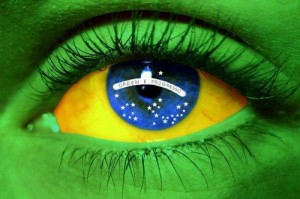 Brazil Population 2013
Brazil Population 2013
The current population of the Federative Republic of Brazil is estimated to be about 199.321 million people, which is an increase of about 1.3% from the last record of the population. Historically, the population of Brazil has been greater than the population of Mexico, but less than the population of the United States of America. Based on the total land area and the total population of the country, the population density of Brazil is about 60.63 people per square mile.
Demographics of Brazil
The largest ethnic group in the Federative Republic of Brazil identifies themselves as white. In fact, 55% of the population identifies as white. The next largest ethnic group is those that identify as mestizo, which makes up about 38% of the population. The rest of the population is made up of Asian, Amerindian, and Black. The official language of Brazil is Portuguese, which the majority of the population speaks. Because Brazil is the only country in the Americas that speaks Portuguese, language is an important aspect of the culture and society.
Religion in Brazil
The largest religious group in the Federative Republic of Brazil happens to be the Roman Catholic Church, making up over 75% of the population. In fact, when European settlers ended up making Catholicism the official religion of the country in the 19th century. Despite this fact, the population is a very diverse religious population. The majority of the population does identify as a member of a religious organization. Others are members of various other Christian denominations, Judaism, Islam, Buddhism, or Spiritism. There are many other minor religions, though, throughout the country.
Animals in Brazil
In the animal kingdom, there is general consensus, that Brazil has the highest number of both terrestrial vertebrates and invertebrates of any country in the world. This high diversity of fauna can be explained in part by the sheer size of Brazil and the great variation in ecosystems such as Amazon Rainforest, Atlantic Forest and Cerrado. The numbers published about Brazil’s fauna diversity vary from source to source, as taxonomists sometimes disagree about species classifications, and information can be incomplete or out-of-date. Also, new species continue to be discovered and some species go extinct in the wild. Brazil has the highest diversity of primates (77 species) and freshwater fish (over 3000 species) of any country in the world. It also claims the highest number of mammals with 524 species, the second highest number of amphibians with 517 species and butterflies with 3,150 species, the third highest number of birds with 1,622 species, and fifth number of reptiles with 468 species. There is a high number of endangered species, many of which live in threatened habitats such as the Atlantic Forest or the Amazon Rainforest.
Tropical Forests in Brazil
Brazil also possesses the world’s largest extent of tropical forest, with 357 million hectares (145 million acres), equivalent to one-third of the world’s total, and three times that possessed by Indonesia, the nation in second place. Brazil has more forest than all of Asia, all of Africa, all of Central America, and all of the remaining South America combined. Sixty-two percent of the Amazonian forest belongs to Brazil, and about 70% of it is still reasonably intact. The northern and western portions of Brazilian Amazonia host the largest pristine block of rainforest wilderness on earth. Deforestation, which is effected primarily to make space for cattle ranching, agriculture, mining, and timber exploitation, is an extremely serious and continuing agent of destruction. A satellite-based analysis has demonstrated that, in 1987 alone, more than 8 million hectares (3.2 million acres) of forest were felled or burned.
 Sports in Brazil
Sports in Brazil
The most popular sport in the Federative Republic of Brazil is considered to be football (American soccer). In fact, the largest soccer stadium in the world is in Brazil, which was built for the 1950 World Cup. Some other popular sports include volleyball, for men and women, basketball, and tennis. Brazil will become the first South American country to host the Olympics after the city of Rio de Janeiro was chosen to stage the 2016 Games. Rio won a majority of the 95 votes at the meeting in Copenhagen, eliminating Madrid in the final round.
Visit Brazil
Historical Population of Brazil
Historically, over the last half of a century, the population of the Federative Republic of Brazil has always increased. This growth has been fairly steady over the years, but has slightly slowed down in the recent decade.
| Year | Population (millions) |
| 1960 | 72.76 |
| 1965 | 84.39 |
| 1970 | 96.08 |
| 1975 | 108.2 |
| 1980 | 121.7 |
| 1985 | 136.2 |
| 1990 | 149.7 |
| 1995 | 161.8 |
| 2000 | 174.4 |
| 2005 | 186 |
| 2010 | 194.9 |
| 2011 | 196.7 |
Projected Population of Brazil
The population of the Federative Republic of Brazil is projected to continue this trend of growth until approximately 2045. The birth rates are projected to decrease over the next 37 years. These rates range from 15.0 births per 1000 people to about 9.7 births per 1000 people. In contrast, the death rates are expected to increase from 6.9 deaths per 1000 people to about 11.4 deaths per 1000 people. Also, the net migration rate is expected to remain negative over the next 37 years, which is another reason as to why the population will eventually decrease.
| Year | Population (millions) | Percent Increase |
| 2015 | 202.826 | 1.80% |
| 2020 | 209.575 | 3.30% |
| 2025 | 215.032 | 2.60% |
| 2030 | 218.878 | 1.80% |
| 2035 | 221.026 | 0.98% |
| 2040 | 221.594 | 0.26% |
| 2045 | 220.701 | -0.40% |
| 2050 | 218.655 | -0.93% |


